Influence of a Guide Net on the Presence and Behavior of Fish Near the Selective Water Withdrawal Structure in Lake Billy Chinook, Oregon, 2022
Links
- Document: Report (10.5 MB pdf) , HTML , XML
- Download citation as: RIS | Dublin Core
Acknowledgments
This study was completed with assistance from many people and organizations, including Portland General Electric staff at Lake Billy Chinook and Round Butte Dam. Gonzalo Mendez, Wesley McDaniel, Matt Gibson, Sophia Madden, Micah Bennett, and Renny Schmidt were especially instrumental in coordinating our activities, installing equipment, monitoring the imaging sonar at the surface water withdrawal structure, and reviewing this report. Our administrative and scientific colleagues at the Columbia River Research Laboratory substantially contributed to this study. This report was improved by reviews from Gabriel Hansen and Brady Allen, consistent with U.S. Geological Survey Fundamental Science Practices. Data are not currently available from Portland General Electric. Contact Portland General Electric for further information.
Abstract
Imaging sonar was used to assess the influence of a fish guidance net, installed at the entrances to the selective water withdrawal (SWW) intake structure, in the forebay of Round Butte Dam, Oregon, on behavior, abundance, and timing of fish during the spring of 2022. The purposes of the SWW are (1) to direct surface currents in the forebay to attract and collect downriver migrating juvenile salmonid smolts (Chinook salmon [Oncorhynchus tshawytscha], sockeye salmon [O. nerka], and steelhead [O. mykiss]) from Lake Billy Chinook and (2) to enable operators of the SWW to withdraw water from surface and benthic elevations in the reservoir to manage downriver water temperatures. Part of the evaluation to determine how well the structure performs at collecting juvenile salmonids is (1) to regularly assess how fish are approaching the entrance, and (2) determine if operational flows and the installation of a guidance (lead) net near the SWW structure entrance can be optimized to increase the attraction of smolts present in the forebay of Lake Billy Chinook. The goal of this study was to provide data about the effects of the installation of a lead net on the movements and behaviors of juvenile salmonids near the entrance to the SWW to help inform decisions to improve downstream passage solutions.
Two imaging sonar units were deployed during the spring 2022 smolt out-migration period. One unit monitored fish movements near the south entrance and one unit monitored movements near the north entrance of the SWW, with the lead net between the two entrances. Both smolt and bull trout (Salvelinus confluentus)-size fish were regularly observed near the entrances, with greater abundances observed at night, corresponding with greater discharge through the SWW, as opposed to during the day when discharge was reduced. Smolt-size fish groups were primarily observed near the interior halves of each SWW entrance, and greater abundances of fish were observed at the south entrance. Increased counts of bull trout-size fish coincided with the increased abundances of smolt-size fish. Overall, the results indicate that (1) smolt-size fish were more abundant near the entrance of the SWW during periods of increased discharge, (2) bull trout-size fish were present at the SWW, and (3) a greater percentage of smolt-size fish were observed directed toward the entrances of the SWW during periods of increased discharge. The addition of the lead net may assist in orienting fish toward the entrances to the SWW.
Introduction
Portland General Electric Company (PGE) and the Confederated Tribes of the Warm Springs Reservation of Oregon (CTWSRO) own and operate the Pelton Round Butte Hydroelectric Project (hereinafter referred to as “Project”) in central Oregon, which includes a series of three dams in the Deschutes River canyon (fig. 1). The primary purpose of the Project is hydroelectric power generation, but it also provides flood-risk management, water for instream flows for fish and wildlife, and opportunities for recreation. Round Butte Dam is the largest hydroelectric dam in the state of Oregon; it is on the Deschutes River in central Oregon, approximately 16 kilometers southwest of Madras. The dam, completed in 1964, impounds Lake Billy Chinook, just downstream from the tributary confluences of the Metolius, Deschutes, and Crooked Rivers. A juvenile bypass system, intended for routing anadromous Chinook salmon (Oncorhynchus tshawytscha), sockeye salmon (O. nerka), and steelhead (O. mykiss) smolts around the dam, went into operation after dam construction; however, low attraction flow and confounding forebay surface currents resulted in minimal fish bypass and fish passage operations stopped in 1966 (Korn and others, 1967; Baker-Jud, 2006). To restore fish passage of juvenile salmonids, PGE and CTWSRO determined that a surface water collection facility was required as part of a water quality improvement and comprehensive fish passage plan mandated by the Federal Energy Regulatory Commission for Project relicensing (Portland General Electric Company, 2004; Federal Energy Regulatory Commission, 2005). The use of these collection devices is preferable because they offer a pre-passage alternative to common spillway and turbine routes, which have been associated with elevated mortality rates (Sweeney and others, 2007; Keefer and others, 2013). Previous studies in other reservoirs have found that surface water collection and fish bypass can be a viable method to improve survival of out-migrating smolts (Sweeney and others, 2007; Adams and others, 2014).
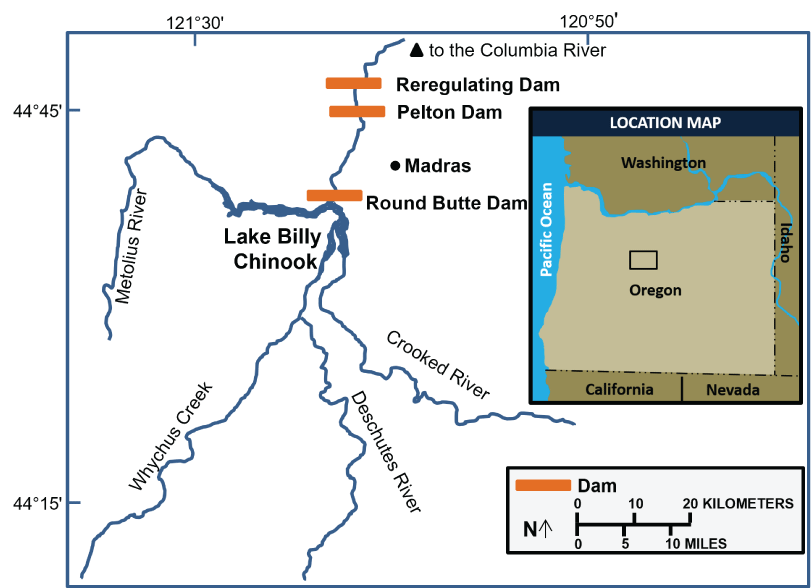
Map of the Deschutes River showing Round Butte Dam and Lake Billy Chinook, Oregon.
In December 2009, a selective water withdrawal (SWW) facility, installed in the forebay of Lake Billy Chinook, alongside Round Butte Dam, began operation. The purpose of the SWW is twofold. First, the SWW directs surface currents in the forebay toward the intake structure and attracts downriver migrating juvenile salmonid smolts (hereinafter referred to as “smolts”), including Chinook salmon, sockeye salmon, and steelhead into the SWW entrances, where they may be collected for subsequent transport around the Project. Second, the SWW allows operators to withdraw reservoir water from surface and benthic elevations from the Lake Billy Chinook forebay to manage water temperatures in the Deschutes River, downriver from Round Butte Dam.
Imaging sonar studies conducted in 2020 and 2021 at the SWW examined movements and behaviors of fish near the entrance to the SWW, as well as the effects of discharge and flow timing conditions (Smith and Hatton, 2022; Smith and others, 2022). For this current study, we examine the effect of a lead net on movements and behaviors of fish near the entrance to the SWW. The 61-meter (m) lead net was installed in 2022 prior to the juvenile salmonid outmigration period. The net is positioned between the entrances of the SWW structure and is intended to guide juvenile salmonids toward the collector and limit milling behavior in front of the collector, which is believed to reduce collection efficiency.
This study used data recorded from imaging sonar to summarize the presence and behavior of juvenile salmonids and predator presence at the SWW during the spring of 2022. Information about fish arrival timing, abundance, movement, and behavior at the SWW during operating flow conditions, with the addition of a guidance structure can inform operation decisions about downstream passage alternatives. This information should enable better characterization of the response of smolts in relation to environmental, biological, and physical factors such as fish size, discharge, and the presence of a guidance structure.
Imaging sonar is capable of recording near-video quality sonar images in various habitats and environmental conditions (Tiffan and others, 2005; Doehring and others, 2011; Able and others, 2014). An advantage of using imaging sonar for behavioral observations of aquatic species is that the images are constructed from data collected from target ensonification and not from methods requiring visual observation. Therefore, data collection can occur in turbid conditions (Liedtke and others, 2013) without altering fish behavior or can be used at night without a supplemental light source to investigate diurnal effects, which are important behavioral factors for migrating salmonids (Dunbar, 2008; Pavlov and others, 2009). Data collected with the imaging sonar provides information on fish size, movement direction, habitat use, and fish travel speed.
The study was designed to provide information for the following objectives:
Methods
Study Area
Round Butte Dam is a 134-m high and 402-m wide, rockfill embankment dam. At the base of the dam is a powerhouse containing three Francis turbine units capable of generating a total of 324 megawatts (fig. 2). During normal operations, all water passing the dam goes through the powerhouse intake, approximately 200-m upstream from the dam. An emergency spillway with a single radial gate is to the west of the dam but is not used during normal dam operations. The 1,619-hectare (ha) Lake Billy Chinook has a storage capacity of 65,991 hectare-meters (ha-m), but a usable storage capacity of 33,797 ha-m. The forebay elevation typically fluctuates plus or minus (±) 1 m during normal weather and project operations.
The fish collection structure of the SWW (fig. 3) is approximately 27 m wide × 46 m long × 24 m tall in size, extends to a depth of approximately 14 m, and has water drawn from the surface of the reservoir. This water is directed to the power intake via a vertical flow conduit, with a maximum inflow of 6,992 cubic feet per second (ft3/s). Discharge herein is presented in cubic feet per second (ft3/s), according to the local reporting conventions of both the U.S. Geological Survey (USGS) and PGE. In total, the SWW structure is 83 m in height. Fish enter either the north or south collector flume (9.6 m wide × 12.2 m deep), move past dewatering screens, and then pass directly into a pipe that delivers them into the fish transfer facility alongside the SWW. At the fish transfer facility, fish are sorted and identified before being trucked and released into the Deschutes River downstream from the Project. The SWW collector is placed near the north shore of the reservoir and over the turbine intake. In 2022, from March 15 to June 15, the SWW followed a nighttime generation operation protocol, whereby the Project attempted to maintain a nightly minimum flow of 4,500 ft3/s to increase attraction flow during periods of active smolt migration. Additional information on SWW operations and performance may be found in Pyper and others (2017), and Portland General Electric Company and The Confederated Tribes of the Warm Springs Reservation of Oregon (2015, 2018), Smith and Hatton (2022), and Smith and others (2022).
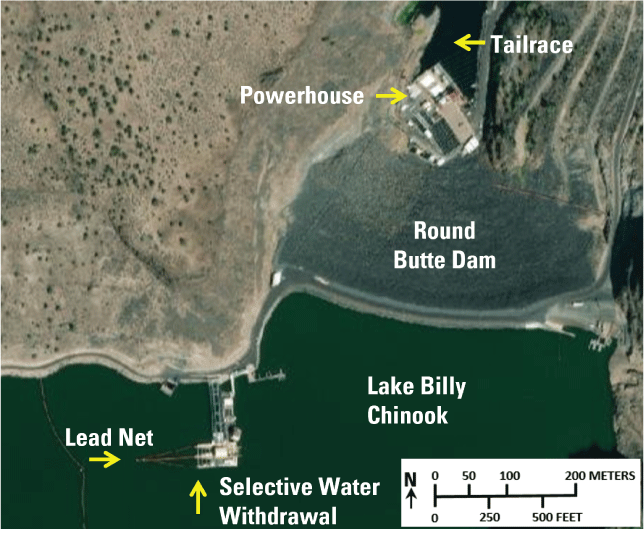
Selective water withdrawal structure at Round Butte Dam, Oregon. Photograph by Landsat, U.S. Geological Survey, September 19, 2022.
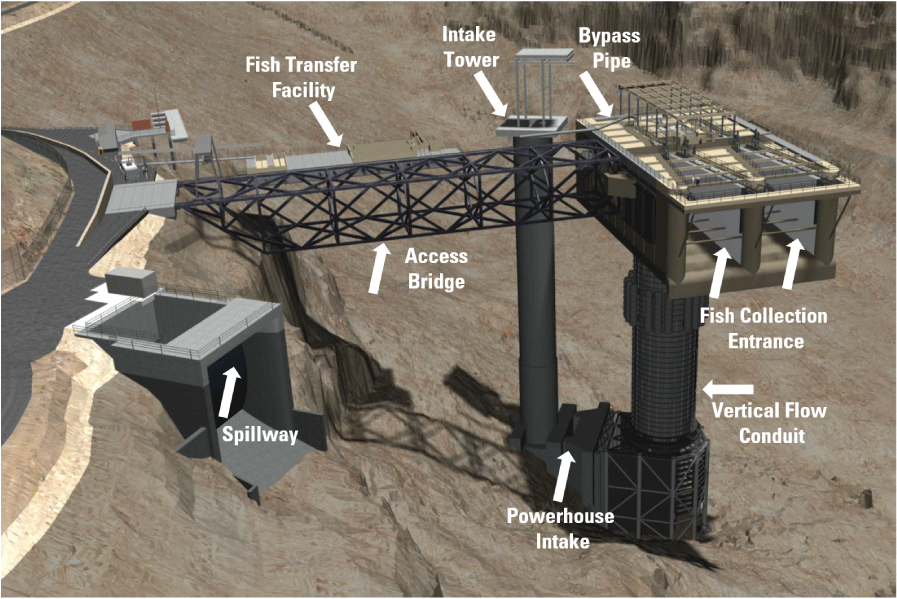
Selective water withdrawal tower and surface collector at Round Butte Dam, Lake Billy Chinook, Oregon. Image courtesy of Portland General Electric; used with permission.
Dam Operations and Environmental Conditions
Project discharge, forebay elevation, and water temperature data were summarized to document the environmental conditions that fish experienced from March 17 to June 15, 2022. Hourly data were collected and provided by PGE. Water temperature data were collected at a water quality monitoring station in the forebay at 2 m in depth and turbidity measurements were collected from the tailrace. Tributary inflow data were collected at the U.S. Geological Survey stream gages on the Deschutes and Crooked rivers near Culver, Oregon (U.S. Geological Survey, 2022a, b), and the Metolius River near Grandview, Oregon (U.S. Geological Survey, 2022c). Data were summarized using hourly observations, but mean daily values were used to increase plot clarity.
Imaging Sonar Deployment and Data Processing
Adaptive resolution imaging sonar systems were used to collect data of fish movements immediately upstream of the SWW entrances. The sonars were operated at 1.8 megahertz (MHz), with an operating range of 2–12 m. Sonars were attached to a pole-mounted platform between the collector entrances, deployed 3.5 m below the water surface at the center of the collector, and aimed perpendicular to each entrance (fig. 4).
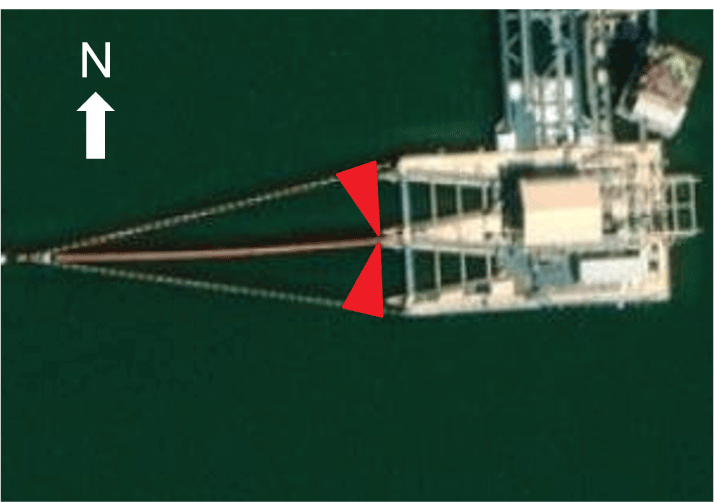
Lake Billy Chinook selective water withdrawal surface collector and approximate coverage areas of the adaptive resolution imaging sonar units (red triangles) in the forebay at Round Butte Dam, Oregon, 2022. Photograph by Landsat, U.S. Geological Survey, September 19, 2022.
The imaging sonars collected data continuously at the SWW from March 17 to June 15, 2022 to coincide with the peak outmigration timing of salmonid smolts. Data collection was interrupted only when the SWW was non-operational because of maintenance or when equipment malfunctioned. All data collected were stored on hard drives for archival and subsequent processing. Over the duration of the study, 91 dates with complete 24-hour sampling periods were included in the analysis.
The image recognition and tracking programs used for identifying fish targets at the entrances used four types of software to prepare and process the collected acoustic signals. Initially, ARISFish software (Sound Metrics, 2018) removed acoustic noise from the collected files. Then, files were parsed to time sequential images using MATLAB software (The Math Works, 2019). Next, computer vision software, OpenCV (2020) was used to locate fish target positions in the sequential images. Finally, target tracking algorithms developed in Python software (Python Core Team, 2020) were applied to the located targets to determine individual fish behavioral and morphometric data.
Imaging sonar technology cannot distinguish individual fish that have entered and exited the field of view multiple times; therefore, the following analysis assumes that each fish track, not the fish, were independent observations. Additionally, it is not possible to definitively identify the species of fish observed; however, if discrete group sizes were present and identifiable through other methods (in other words, collection), informed inferences of species can be made. Despite these limitations, imaging sonar can be used to collect data that would otherwise be unattainable.
Summary statistics of fish targets derived from signal processing (mean length, direction, speed, and location in beams) were imported into SAS software (SAS Institute, 2012), for subsequent proofing and to merge imaging sonar data with the environmental data. Data were proofed to eliminate non-valid records or records that did not provide measurable morphometric or behavioral data. Target datasets were then exported for additional statistical analysis using R software (R Core Team, 2014).
Fish Size and Count
Fish targets were grouped into three size classes to distinguish between Chinook and sockeye smolt-size fish (95–190 millimeters [mm]), kokanee (lacustrine sockeye salmon [O. nerka]) or steelhead smolt-size fish (190–300 mm), and the primary piscivorous fish found in the reservoir, adult bull trout (greater than [>] 350 mm). Kokanee, which are “landlocked,” non-migrating sockeye salmon, are returned to Lake Billy Chinook, rather than collected and passed downstream of the Project. Observations of kokanee were included in analysis with the smolts hereinafter. In addition to fish size, run timing allowed the approximate species differentiation between kokanee and steelhead occurring before and after May 3, 2022, as determined by observations of fish collected at SWW collection facility (Gonzalo Mendez, PGE, written commun., August 10, 2022). Fish 190–300 mm total length (TL) observed before April 24 were classified as kokanee, whereas fish of the same size class observed after April 24 were classified as steelhead. Fish 300–350 mm TL were not included in the analyses because of the overlap between large kokanee, large steelhead, and small bull trout, though observations were rare. In addition to bull trout, adult rainbow trout (O. mykiss), brown trout (Salmo trutta), and smallmouth bass (Micropterus dolomieu) are other known predators of salmonid smolts present in the reservoir that could be observed with the imaging sonar; however, these are seldom captured at the SWW. Additionally, although salmonid fry (less than [<] 95 mm) were occasionally observed, those observations were not included in this analysis because of the inability to assign species classification.
Direction of Fish Travel
The influence of discharge rates on the general direction of travel (toward or away from the SWW) of smolt size groups was analyzed. Discharge rates were based on discharge values recorded at the time of fish observation. A chi-square goodness-of-fit test was performed to determine if the directions of travel were statistically different across discharge rates (Zar, 1999; Agresti, 1996). To determine a measure of effect size for tests of association for nominal variables, a variant of the Cramér's V for goodness-of-fit tests was calculated (Mangiafico, 2016). Cramér's V will vary from 0 to 1, where a value of 0 indicates no variation in category proportions (no effect) and a value of 1 indicates pronounced variation within category proportions (strong effect). Statistical analyses were done using R software (R Core Team, 2014) with package rcompanion for Cramér's V. To test the difference in observed proportions of fish traveling toward the SWW between data collected during study years 2021 and 2022, a two-proportion z-test was used following Wilson (1927) using R software (R Core Team, 2014). A significance level of α=0.05 was used for all tests.
Track Characteristics
Fish-track characteristics were quantified using the travel speed variable obtained from individual fish tracks. Travel speed was calculated as the average travel velocity of each individual target. An analysis of variance (ANOVA) was used to determine the significance of the differences for fish sizes for observations at both the north and south entrances. If significant differences were found using ANOVA, an F-test by fish-size groups and Tukey’s Honestly Significant Difference (HSD) test (Sokal and Rohlf, 1969) were used to locate the pairwise differences in concentrations between groups. Additionally, two-sample t-tests were used to determine if there were differences in swimming velocity for each fish-size class observed between the two entrances. Statistical analyses were done using R software (R Core Team, 2014), with a significance level α=0.05.
Evaluating the Fish Track Density Near the Selective Water Withdrawal Entrances
The collected point samples for each individual fish track were used to create two-dimensional density plots of unique fish track locations for the volume sampled. Individual data points were centered using a smooth kernel function at each observation point and then summed to get a density estimate using the MASS package for R software (R Core Team, 2014). The magnitude of the point count is defined as the count of unique observations of each individual fish location at each observation point. Datasets for each fish size group were used for plotting point location data, and locations observed for data collected in combined study years 2020 and 2021 (absence of the lead net) were included for graphical comparison.
Results
Dam Operations and Environmental Conditions
A combination of upper basin reservoir water storage for irrigation and lower than average precipitation in 2022 resulted in reduced instream flows during March and April compared to normal flows during a typical spring on the Deschutes, Crooked, and Metolius Rivers (fig. 5). However, by May, instream flows returned to above or near-median levels for the remainder of the observation period. The median hourly SWW discharge was 3,235.2 ft3/s (range 118.8–5,778.3 ft3/s; fig. 6; table 1). The spillway was not opened during the study and all water passed through the SWW, with a peak daily mean discharge of 3,972.5 ft3/s occurring on June 12, 2022. The reservoir elevation was maintained at a constant daily elevation of nearly 1,944.4 feet above National Geodetic Vertical Datum of 1929 for the entirety of the study, with a 1.5-foot fluctuation (table 1). Water temperature generally increased through the study period, peaking at 16.5 degrees Celsius on June 9, 2022, whereas the lowest water temperature of 8.8 degrees Celsius occurred on April 20, 2022 (table 1; fig. 6).
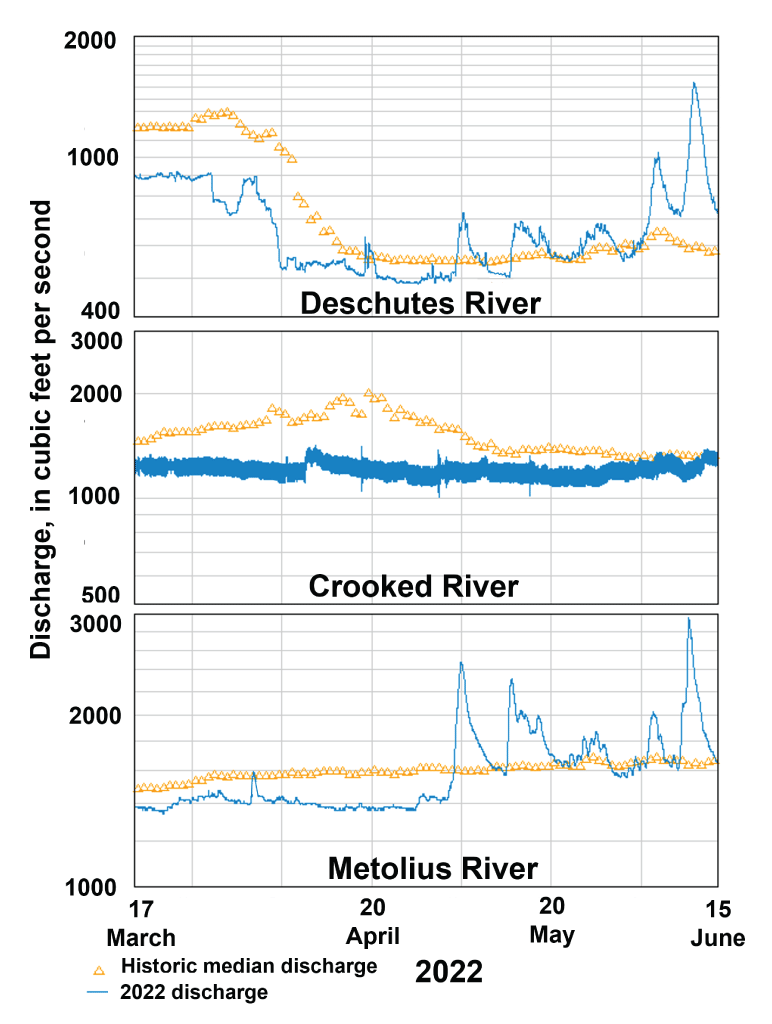
Discharges of Deschutes, Crooked, and Metolius Rivers from U.S. Geological Survey hydrological sites near Lake Billy Chinook, Oregon, March 17–June 15, 2022. Discharges (y-axes) are depicted in traditional non-linear intervals for visualizing detail in both high and low flow conditions. Graphs produced from data in U.S. Geological Survey (2022a–c).
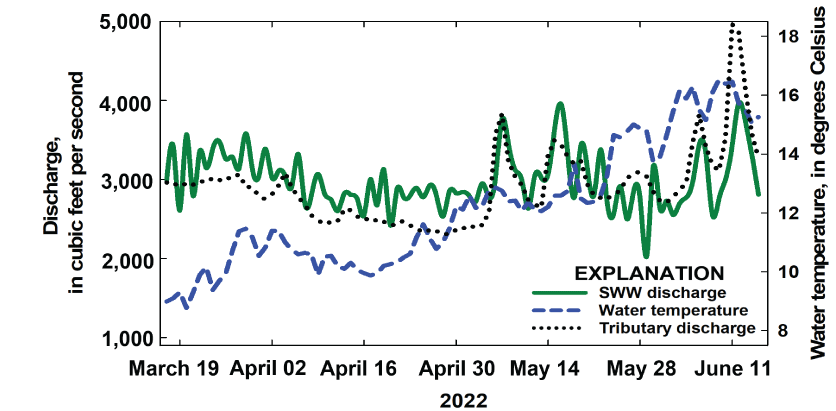
Selective water withdrawal (SWW) discharge, water temperature, and tributary discharge of Deschutes, Crooked and Metolious Rivers at Lake Billy Chinook, Oregon, March 17–June 15, 2022.
Table 1.
Summary statistics of hourly dam operations and environmental conditions at Round Butte Dam, Oregon, March 17–June 15, 2022.[Abbreviations: SD, standard deviation; ft3/s, cubic foot per second]
Fish Abundance
Data from the imaging sonars indicate that abundances of both smolt and bull trout-size fish near the entrances of the SWW varied while the migration season progressed (fig. 7). Abundance of fish observed on both imaging sonars generally were lowest during late-March, then trended upward to a peak abundance of 7,007 fish per day on May 18, before decreasing to a low of 210 fish per day on June 9. Fish observations were largely dominated by smolt-size fish; however, the daily abundance trends of adult bull trout-size fish were low (range 4–145 daily) and generally corresponded with that of the smolt-size fish.
In total, 128,912 fish observations were recorded, with approximately 12 percent more fish observed at the south entrance (n=72,407) than at the north entrance (n=56,505; table 2). The Chinook and sockeye smolt-size fish group (95–190 mm) was the predominant size class observed, constituting 64 percent of the total observations. The steelhead and kokanee fish-size groups represented 24 and 9 percent of observations, respectively, whereas the adult bull trout-size group constituted 3 percent of total observations.
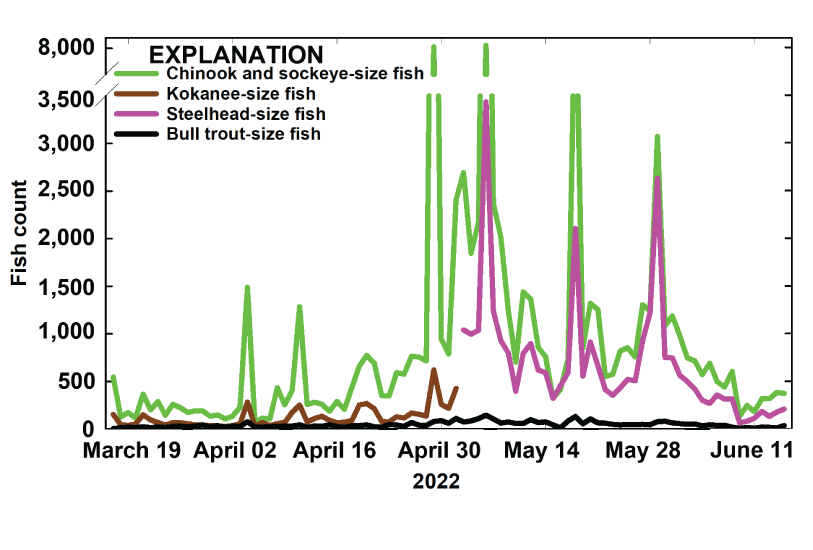
Daily count (on the date of detection) of smolt and bull trout (Salvelinus confluentus)-size fish at the collector entrances using the adaptive resolution imaging sonar at the selective water withdrawal collector at Lake Billy Chinook, Oregon, 2022.
Table 2.
Count and size of smolt and bull trout-size fish at the location of detection at the collector entrances observed using the adaptive resolution sonars at the selective water withdrawal collector at Lake Billy Chinook, Oregon, 2022.[Sample size is the number of fish observation events with the imaging sonars, not necessarily the number of individual fish, because a given fish could be observed more than once. Chinook, Oncorhynchus tshawytscha; sockeye/kokanee, Oncorhynchus nerka; steelhead, Oncorhynchus mykiss; bull trout, Salvelinus confluentus. Abbreviations: mm, millimeter; N, sample size; SD, standard deviation; >, greater than]
Direction of Travel
The general direction of travel of the three smolt-size fish groups near the entrance to the SWW depended on fish group, entrance, and sometimes discharge (fig. 8). Near the north entrance, the general directions of travel (either toward or away) of the Chinook and sockeye smolt-size fish group were toward the entrance at all discharge levels through the SWW, with moderate effect values indicated by Cramér’s V at discharge levels greater than 1,000 ft3/s (table 3). The directions for kokanee-size fish were like the Chinook and sockeye smolt-size fish group, with directions toward the entrance at all discharge levels. The general direction of travel became near 50 percent, either toward or away from the entrance when discharge was less than 2,000 ft3/s, with low Cramér’s V scores indicating weak effects for travel direction (table 3). For steelhead smolt-size fish, the general directions of travel at all discharge rates were toward the entrance, with moderate effect values (Cramér’s V>0.29) at all discharge rates (table 3).
Near the south entrance, the general direction of travel of the Chinook and sockeye smolt-size group was toward the entrance when discharge through the SWW was greater than 1,000 ft3/s, with moderate effect values indicated by Cramér’s V (table 3). However, when discharge was between 3,000 and 4,000 ft3/s, the general direction of travel became near 50 percent, either toward or away from the entrance, but with a weak effect indicated by Cramér’s V. The directions for kokanee-size fish were similar to observations at the north entrance, with directions toward the entrance at all discharge levels, and the general direction of travel became near 50 percent, either toward or away from the entrance when discharge was less than 2,000 ft3/s, with low Cramér’s V scores (<0.10) indicating weak effects for travel direction (table 3). For steelhead smolt-size fish, the general directions of travel at all discharge rates were toward the entrance, with moderate effect values (Cramér’s V>0.28) at all discharge rates above 1,000 ft3/s (table 3).
Differences in observations of the three smolt-size fish groups traveling toward the entrance to the SWW before the lead net was installed (2021) and following installation (2022) depended on fish group and discharge (table 4). Travel toward the SWW was significantly increased under all discharge levels for the Chinook and sockeye smolt-size fish group in 2022 (p<0.001). The directions for kokanee-size fish were near 50 percent toward the entrance when discharge was less than 2,000 ft3/s during both sampling years. When discharge was greater than 2,000 ft3/s travel toward the SWW was significantly increased in 2022 (p<0.001). For steelhead smolt-size fish, travel toward the SWW in 2022 was significantly increased under all discharge levels except for when discharge was between 3,000 and 4,000 ft3/s (p=0.418); however, the direction of travel remained predominantly toward the SWW (66.4 percent).
Table 3.
General direction of travel for smolt-size fish observed at binned flow increments using the adaptive resolution imaging sonar at the entrances of the selective water withdrawal collector at Lake Billy Chinook, Oregon, 2022.[Direction is either toward or away from the collector. Sample size is the number of fish observation events with the imaging sonar, not necessarily the number of individual fish, because a given fish could be observed more than once. Chinook, Oncorhynchus tshawytscha; sockeye/kokanee, Oncorhynchus nerka; steelhead, Oncorhynchus mykiss. Abbreviations and symbols: mm, millimeter; ft3/s, cubic foot per second; N, sample size; %, percentage; X2, Chi-square test; <, less than; >, greater than]
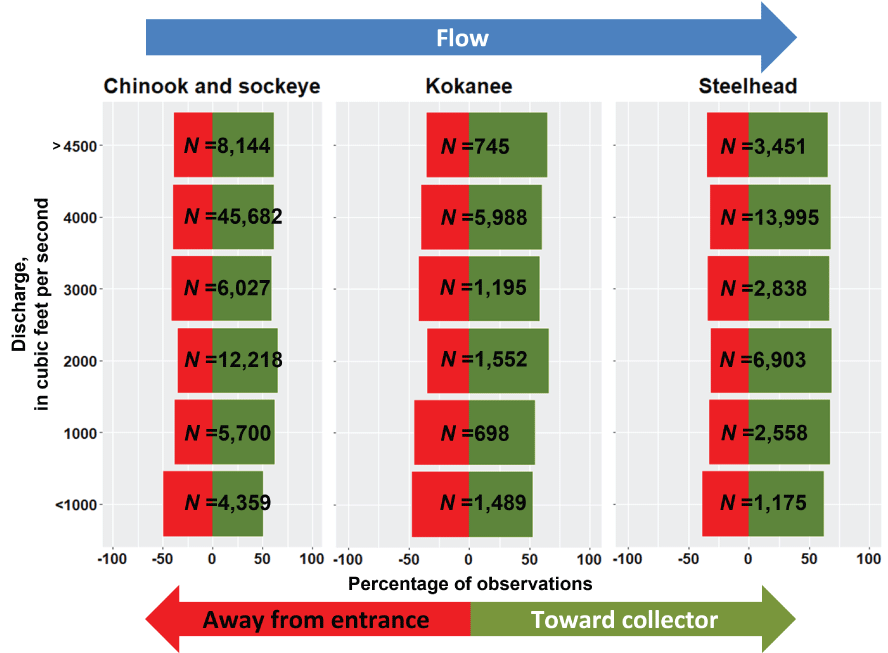
Directional travel for smolt-size fish observed at the collector entrances under different discharge levels using the adaptive resolution imaging sonars at the selective water withdrawal collector at Lake Billy Chinook, Oregon, 2022. Sample sizes represent the number of smolt-size fish (N) observed.
Table 4.
Comparison of travel toward the entrances of the selective water withdrawal collector for smolt-size fish observed at binned flow increments using the adaptive resolution imaging sonar at Lake Billy Chinook, Oregon, 2021–22.[Sample size is the number of fish observation events with the imaging sonar, not necessarily the number of individual fish, because a given fish could be observed more than once. Chinook, Oncorhynchus tshawytscha; sockeye/kokanee, Oncorhynchus nerka; steelhead, Oncorhynchus mykiss. Abbreviations and symbols: mm, millimeter; ft3/s, cubic foot per second; N, sample size; %, percentage; X2, Chi-square test; <, less than; >, greater than]
Fish Swimming Velocity
The speed at which fish traveled at the entrances of the SWW generally differed between the fish-size classes, as well as between the two entrances (table 5; fig. 9). For example, at the north entrance, the mean swimming velocity of Chinook and sockeye smolt-size fish was 0.29 meters per second (m/s; interquartile range [IQR]=0.23), 0.35 m/s (IQR=0.26) for kokanee-size fish, 0.33 m/s (IQR=0.23) for steelhead-size fish, and 0.41 m/s (IQR=0.29) for bull trout-size fish. These differences in fish swimming speed were significant between fish sizes (ANOVA; F3, 56,501=537.0, p<0.001) with mean swimming speeds varying irrespective of size groups. Results of the post hoc Tukey HSD test indicate that the swimming speeds of all fish-size groups had significantly different swimming speeds from each other (p<0.01).
At the south entrance, the mean swimming velocity of fish was slower than observed at the north entrance, with Chinook and sockeye smolt-size fish velocities at 0.23 m/s (IQR=0.20), 0.29 m/s (IQR=0.25) for kokanee-size fish, 0.28 m/s (IQR=0.19) for steelhead smolt-size fish, and 0.36 m/s (IQR=0.29) for bull trout-size fish. These differences in fish swimming speed also were significant between fish sizes (ANOVA; F3, 72,403=802.7, p<0.001). Results of the post hoc Tukey HSD test indicate that the swimming speeds of the steelhead smolt-size group and the kokanee-size group were not significantly distinguishable from each other (p=0.053), whereas all other fish size groups had significantly different swimming speeds (p<0.001).
When observations of fish were compared between the north and south entrances, swimming velocities were statistically different for each of the fish-size groups (at the α=0.05 level) but were unlikely to be biologically significantly different for the smolt-size fish groups. For Chinook and sockeye smolt-size fish, mean swimming velocities were 0.06 m/s different between the two entrances but were significantly different (t; 82,128=51.56, p<0.001). Mean swimming velocities for kokanee-size fish were 0.06 m/s different between the two entrances and were significantly different (t; 11,665=15.41, p<0.001). Swimming velocities for steelhead-size fish were slightly faster at the north entrance (0.33 m/s) than at the south entrance (0.28 m/s) and were significantly different (t; 30,918=27.48, p<0.001). Likewise, bull trout-size fish were slightly faster at the north entrance with a speed of 0.41 m/s, and 0.36 m/s at the south entrance, and were significantly different (t; 4,193=8.18, p<0.001).
Table 5.
Summary statistics for the swimming velocity of fish observed using the adaptive resolution imaging sonars at the entrances at the selective water withdrawal collector at Lake Billy Chinook, Oregon, 2022.[All numbers in the table, except in the fish group, are in meters per second. Sample size is the number of fish observation events with the imaging sonars, not necessarily the number of individual fish, because a given fish could be observed more than once. Chinook, Oncorhynchus tshawytscha; sockeye/kokanee, Oncorhynchus nerka; steelhead, Oncorhynchus mykiss; bull trout, Salvelinus confluentus. Abbreviations and symbol: N, sample size; m/s, meter per second; SD, standard deviation; IQR, interquartile range; <, less than]
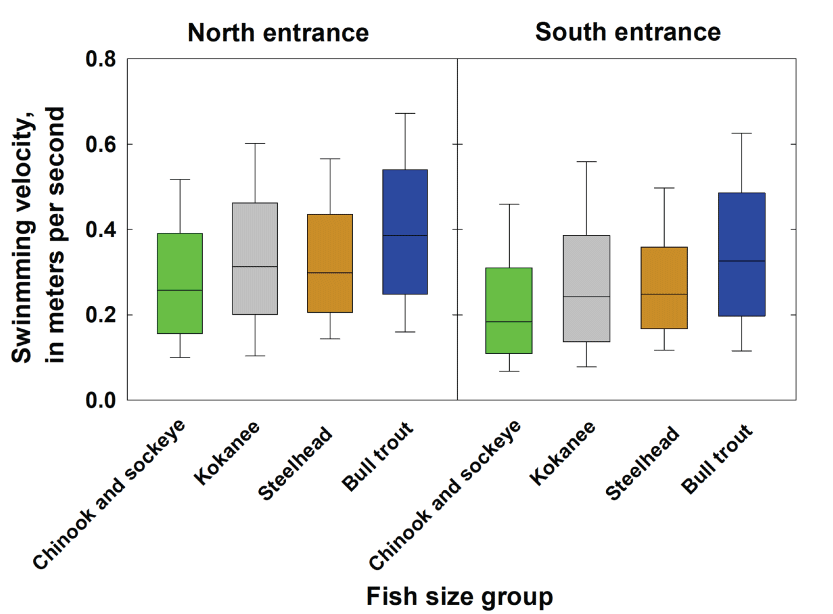
Swimming velocity of fish observed using the adaptive resolution imaging sonars at the north and south entrances at the selective water withdrawal collector at Lake Billy Chinook, Oregon, 2022. Boxes range from the 25th to the 75th percentiles, with lines indicating the medians and whiskers representing 10th and 90th percentiles.
Timing of Detection
The counts of fish observed with the imaging sonars at the SWW entrances differed by discharge. For all fish size groups observed at the entrances, counts were lowest during the daytime periods when discharge rates were reduced (fig. 10). After approximately 1900 hours, counts of steelhead and Chinook and sockeye smolt-size fish groups began increasing approximately 2 hours after the initial increase in discharge, and generally increased through the night. Maximum observations of steelhead and Chinook and sockeye smolt-size fish groups occurred at 0300 hours, before rapidly decreasing to reduced observations during periods of daytime and low discharge rates. General trends in counts of kokanee-size fish were similar to that of the smolt-size fish groups, with the highest counts occurring at 0400 hours, immediately preceding the decrease in discharge. Bull trout-size fish were most abundant at 0300 hours, during the period when smolt-size fish were most abundant.
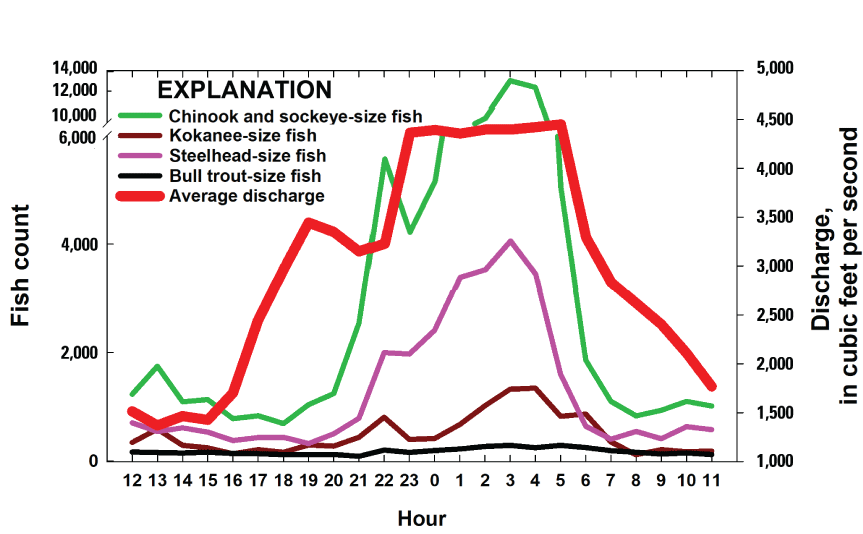
Counts of fish-size groups by hour of detection at the collector entrances using the adaptive resolution imaging sonar at the selective water withdrawal collector at Lake Billy Chinook, Oregon, 2022.
Fish Track Density
The spatial distributions of fish positions near the entrances of the SWW indicate some differences in distribution, depending on the fish size group. The fish location point density data include greater than 3.7 million location points from 128,912 individual tracks that were recorded by the imaging sonars in 2022. Point density data indicate that positions for Chinook and sockeye smolt-size fish observed on the north sonar were centered near the south half of the entrance, with lesser concentrations of positions on the outsides of the SWW structure (fig. 11). However, positions for Chinook and sockeye smolt-size fish observed on the south sonar were nearly spread across the entirety of the south entrance. These 2022 observations were similar to previous observations from the 2020 and 2021 studies for both entrances, except for reduced observations primarily near the area directly between the SWW entrances. Positions for the kokanee group differed at the north and south entrances, with positions from the north sonar nearly spread across the north entrance, while positions from the south sonar were primarily in the north half of the south entrance, with few detections on the far south end of the SWW (fig. 12). Compared to the previous studies, the observations from the north entrance were more spread across the entrance, while the south entrance was similar. Positions for the steelhead smolt-size group were similar at the north and south entrances, with positions primarily observed near the area between the SWW entrances and fewer detections on the far north and far south ends of the SWW (fig. 13). Again, these observations were similar to those from previous studies for the north entrance and reduced observations near the area directly between the SWW entrances for the south entrance. The bull trout-size group positions observed on the north sonar were primarily near the area between the SWW entrances, while positions observed on the south sonar were concentrated approximately a quarter of the distance from the center of the SWW (fig. 14). These observations were similar to the previous study years for the north entrance, while more spread out from the center for the south entrance.
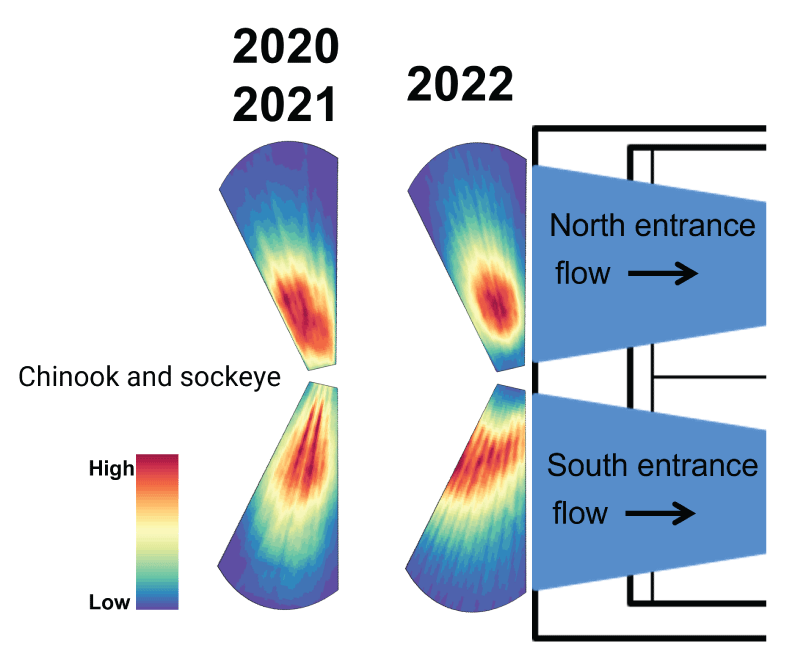
Location point density plot showing chinook (Oncorhynchus tshawytscha) and sockeye (Oncorhynchus nerka) smolt-size fish detected at the collector entrances using the adaptive resolution imaging sonar at the selective water withdrawal collector at Lake Billy Chinook, Oregon, 2022, and also showing the combined 2020 and 2021 detections.
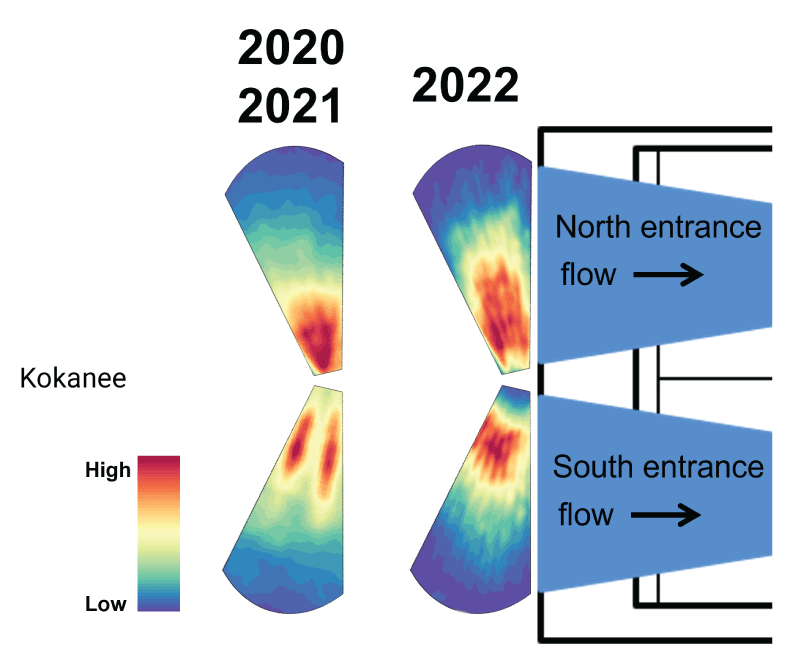
Location point density plot showing kokanee (Oncorhynchus nerka) -size fish detected at the collector entrances using the adaptive resolution imaging sonar at the selective water withdrawal collector at Lake Billy Chinook, Oregon, 2022, and also showing the combined 2020 and 2021 detections.
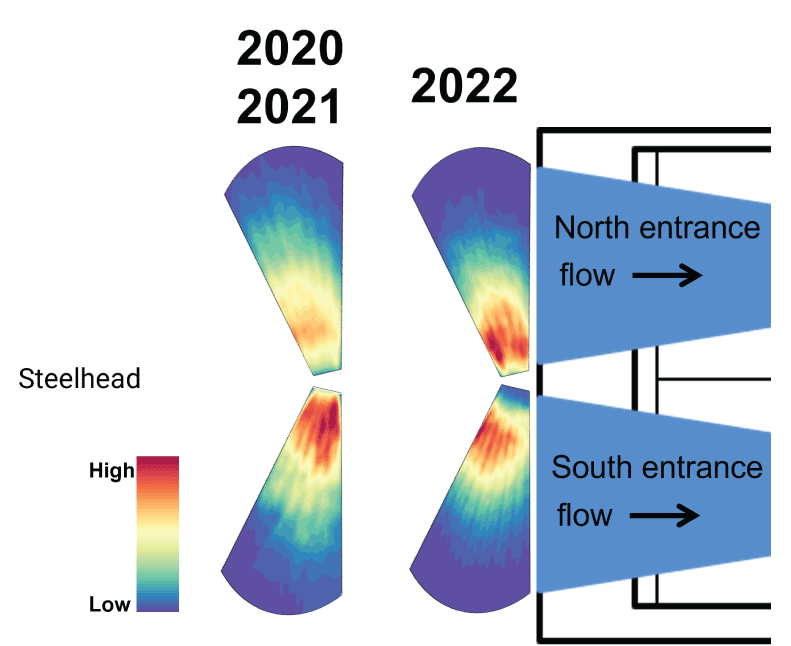
Location point density plot showing steelhead (Oncorhynchus mykiss) -size fish detected at the collector entrances using the adaptive resolution imaging sonar at the selective water withdrawal collector at Lake Billy Chinook, Oregon, 2022, and also showing the combined 2020 and 2021 detections.
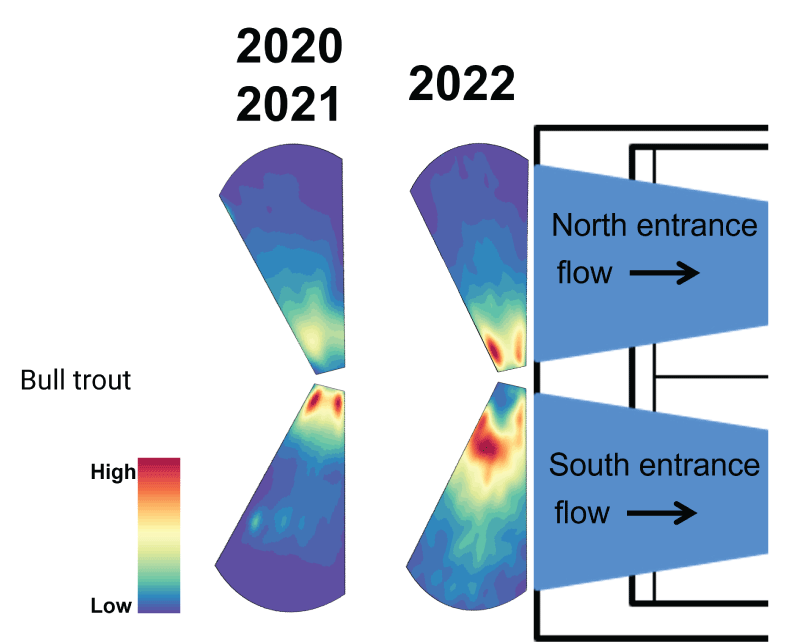
Location point density plot showing bull trout (Salvelinus confluentus) -size fish detected at the collector entrances using the adaptive resolution imaging sonar at the selective water withdrawal collector at Lake Billy Chinook, Oregon, 2022, and also showing the combined 2020 and 2021 detections.
Discussion
In this study, the goals were to observe and describe fish movements at the entrances of the selective water withdrawal (SWW) following the installation of a lead net. We assessed the abundance and movements of smolt and bull trout-size fish at the SWW surface collector, which is operated to entrain and capture downriver migrating salmonids (Oncorhynchus spp.). The imaging sonar technology used in this study observed and monitored smolt and bull trout (Salvelinus confluent)-size fish near the SWW and enabled us to characterize fish behaviors, abundance, and movements at the SWW, verifying if the presence of a lead net influences fish behaviors and abundance.
Imaging sonar technology is capable of monitoring fish activities near collection and guidance structures without affecting fish behavior. However, imaging sonars are limited by a small area of observation, a lack of ability to determine species specificity for fish of similar size, and plural observations of individual fish are possible. Run-timing and size metrics from fish collected at the SWW fish transfer facility were used to classify fish size groups to assume that fish 95–190 millimeters (mm) long were either Chinook (Oncorhynchus tshawytscha) or sockeye (Oncorhynchus nerka) smolts, that fish 190–300-mm long prior to May 3 were kokanee, fish that were 190–300-mm long after May 3 were steelhead (Oncorhynchus mykiss) smolts, and that those greater than 350-mm long were bull trout.
The SWW at Lake Billy Chinook is one of several downstream juvenile migrant collectors in use at dams in the Pacific Northwest (Adams and Smith, 2017; Smith and Hatton, 2022). Inflows at these collectors vary from 250 cubic feet per second (ft3/s) to approximately 5,000 ft3/s at the SWW at Round Butte Dam, which is the greatest inflow used at any surface collector facility. Additionally, other facilities use nets or landform positioning to help guide fish to their entrances. Previously, the SWW had no physical structures to provide directional guidance toward the collector entrance; however, a lead net was installed during the winter of 2022. Kock and others (2019) found that smolt collection rates were generally higher at facilities using both elevated flow rates and guidance structures. The goal of the addition of the guidance net near the entrance to the SWW at Round Butte Dam, coupled with target attraction flow, was to increase fish collection based on the abundance of fish observed near the entrance to the SWW.
Increased observations of smolt-size fish near the entrances of the SWW coincided with elevated discharge produced during night generation operations. Fish counts of all size groups were lowest during the daytime hours when discharge was reduced, then gradually increased at night with the corresponding increase in discharge. Maximum observations of the steelhead and Chinook and sockeye smolt-size fish groups and bull trout-size fish occurred at 0300 hours, and the kokanee-size fish group at 0400 hours, before rapidly decreasing to reduced observations during periods of daytime and low discharge rates. Smolt collection rates at the SWW are typically low during the day, indicating that smolt activity is elevated during nighttime hours (Pyper, 2015).
Behavioral differences were observed for fish near the entrances to the SWW. The swimming velocity of fish at the entrances of the SWW differed at the two entrances and between fish-size classes. Swimming velocity was faster at the north entrance than at the south entrance, and swimming velocity increased with increasing fish size. While the differences were generally statistically significant, the biological significance is small, with differences in swimming velocities less than approximately 0.1 meter per second (m/s) for all fish size groups. The predominant directions of travel for the smolt-size fish groups were toward the entrances to the SWW and were similar between the size groups. However, a larger percentage of fish were directed toward the north entrance than toward the south entrance. Additionally, travel toward the SWW was generally increased under all discharge levels for the smolt-size fish groups in 2022 following the installation of the lead net. These observations indicate that the addition of the lead net, similar to behavioral guidance structures found at other downstream juvenile migrant collectors and power generating dams in the Pacific Northwest (Kock and others, 2019), may assist in orienting fish toward the entrances to the SWW.
Differences in the spatial use of the sonar coverage area for both smolt and bull trout-size fish were observed near the entrances to the SWW. At the north entrance, the steelhead and bull trout-size groups were primarily observed near the area between the SWW entrances, with lesser concentrations of positions on the outsides of the SWW structure and similar to observations for the study years prior to the installation of the lead net. At the south entrance, however, observations for these size groups were spread more across the entirety of the south entrance in 2022. The Chinook and sockeye and kokanee smolt-size fish groups observed on both the north and south sonars were spread more across the entirety of both entrances than were observed prior to installation of the lead net. These spatial patterns of use indicate that Chinook and sockeye and kokanee smolt-size fish are observed in the attraction flow field at the SWW entrances prior to entering, whereas steelhead and bull trout-size fish may be using the lower velocity flow area between the entrances near the north entrance.
Counts of bull trout-size fish were generally low at both entrances of the SWW, with the greatest abundance occurring in conjunction with that of smolt-size fish and during the nighttime period. The presence of predatory fish has been observed at other fish passage structures, although the collection or passage of predator-size fish at these structures is rare (Khan and others, 2012; Beeman and others, 2014, 2016; Adams and others, 2015). Increased abundances of bull trout-size fish at this and other surface collectors during periods of increased smolt-size fish presence indicate that surface collectors may be used as a prey ambush location during periods of juvenile salmonid out-migration (Hill and others, 2013; McIlvaine, 2015; Beeman and others, 2016; Smith and others, 2018; Smith and others, 2021; Smith and Hatton, 2022). The presence of bull trout-size fish near the entrances of the SWW indicates that this structure may be providing physical habitat and increased feeding opportunities for bull trout on migrating salmonid smolts; however, the abundance and habitat use were similar to observations from previous years.
The imaging sonar technology used at the entrance of the SWW in this study were an informative tool for assessing fish abundance, movements, and behaviors. Abundance of smolt-size fish was primarily dictated by the operational flows of the SWW during the nighttime period. Additionally, smolt-size fish observations were generally reduced in the area directly between the entrances at the center of the collector and were more frequently directed toward the entrances of the SWW than were observed during previous study years. The results of this study can be used to help inform resource managers how operational discharge and the addition of a fish guidance structure can influence abundance and behaviors of smolts at the SWW.
References Cited
Adams, N.S., and Smith, C.D., 2017, Spatial and temporal distribution of bull trout (Salvelinus confluentus)-size fish near the floating surface collector in the North Fork Reservoir, Oregon, 2016: U.S. Geological Survey Open-File Report 2017–1080, 27 p., accessed March 1, 2023, at https://doi.org/10.3133/ofr20171080.
Adams, N.S., Smith, C.D., Plumb, J.M., Hansen, G.S., and Beeman, J.W., 2015, An evaluation of fish behavior upstream of the water temperature control tower at Cougar Dam, Oregon, using acoustic cameras, 2013: U.S. Geological Survey Open-File Report 2015–1124, 62 p., accessed March 1, 2023, at https://pubs.er.usgs.gov/publication/ofr20151124.
Beeman, J.W., Evans, S.D., Haner, P.V., Hansel, H.C., Hansen, A.C., Hansen, G.S., Hatton, T.W., Sprando, J.M., Smith, C.D., and Adams, N.S., 2016, Evaluation of the biological and hydraulic performance of the portable floating fish collector at Cougar Reservoir and Dam, Oregon, 2014: U.S. Geological Survey Open-File Report 2016–1003, 127 p., accessed March 1, 2023, at https://pubs.er.usgs.gov/publication/ofr20161003.
Beeman, J.W., Hansel, H.C., Hansen, A.C., Evans, S.D., Haner, P.V., Hatton, T.W., Kofoot, E.E., Sprando, J.M., and Smith, C.D., 2014, Behavior and dam passage of juvenile Chinook salmon at Cougar Reservoir and Dam, Oregon, March 2012–February 2013: U.S. Geological Survey Open-File Report 2014–1177, 52 p., accessed March 1, 2023, at https://pubs.usgs.gov/of/2014/1177/.
Federal Energy Regulatory Commission, 2005, Order approving settlement and issuing new license (Pelton Round Butte Project) for Portland General Electric Company and the Confederated Tribes of the Warm Springs Reservation of Oregon: Washington, D.C., 111 Federal Energy Regulatory Commission 61,450, 298 p.
Hill, M., Quesada, C., Bennett, M., Timko, M., Martinez, M., Rizor, S., Wright, C., Sullivan, L., Meagher, M., and Kukes, T., 2013, Evaluation of juvenile Chinook and steelhead downstream passage behavior and resident bull trout behavior at Round Butte Dam, Madras, Oregon: Portland, Oregon, Portland General Electric Company, 51 p.
Khan, F., Johnson, G.E., Royer, I.M., Phillips, N.R., Hughes, J.S., Fischer, E.S., Ham, K.D., and Ploskey, G.R., 2012, Acoustic imaging evaluation of juvenile salmonid behavior in the immediate forebay of the water temperature control tower at Cougar Dam, 2010: Richland, Washington, Pacific Northwest National Laboratory report PNNL-20625, 50 p., accessed March 1, 2023, at https://www.pnnl.gov/main/publications/external/technical_reports/pnnl-20625.pdf.
Kock, T.J., Verretto, N.E., Ackerman, N.K., Perry, R.W., Beeman, J.W., Garello, M.D., and Fielding, S.D., 2019, Assessment of operational and structural factors influencing performance of fish collectors in forebays of high-head dams: Transactions of the American Fisheries Society, v. 148, no. 2, p. 464–479.
Korn, L., Hreha, L.H., Montagne, R.G., Mullarkey, W.G., and Wagner, E.J., 1967, The effect of small impoundments on the behavior of juvenile anadromous salmonids: Portland, Oregon, Fish Commission of Oregon, 127 p., accessed March 1, 2023, at http://ir.library.oregonstate.edu/xmlui/bitstream/handle/1957/17360/fish_comm_research_briefs_1967_13-1.pdf.
Liedtke, T.L., Kock, T.J., and Rondorf, D.W., 2013, Evaluation of the behavior and movement patterns of adult coho salmon and steelhead in the North Fork Toutle River, Washington, 2005–2009: U.S. Geological Survey Open-File Report 2013–1290, 26 p. [Also available at https://doi.org/10.3133/ofr20131290.]
Mangiafico, S.S., 2016, Summary and analysis of extension program evaluation in R, version 1.19.10: New Brunswick, New Jersey, Rutgers Cooperative Extension, 806 p., accessed March 1, 2023, at https://rcompanion.org/documents/RHandbookProgramEvaluation.pdf.
McIlvaine, P., 2015, Application review for low impact hydropower institute re-certification of the Pelton-Round Butte Project No. 2030: Topsham, Maine, Wright-Pierce, 27 p., accessed March 1, 2023, at https://lowimpacthydro.org/wp-content/uploads/2020/07/Pelton-Round-Butte-Final-Report-Sept-2015-1.pdf.
OpenCV, 2020, Open Source Computer Vision Library, version 4.4.0: Santa Clara, California, Intel Corporation, accessed November 2022, at https://opencv.org/releases/.
Portland General Electric Company, 2004, Settlement agreement concerning the relicensing of the Pelton Round Butte Hydroelectric Project (FERC Project No. 2030): Portland, Oregon, Portland General Electric Company, 230 p., accessed March 1, 2023, at https://lowimpacthydro.org/wp-content/uploads/2020/07/3PRBSettlementAgreement7-16-04FINAL.pdf.
Portland General Electric Company and The Confederated Tribes of the Warm Springs Reservation of Oregon, 2015, Pelton Round Butte Project (FERC No. 2030) 2015 fish passage annual report: Portland, Oregon, Portland General Electric Company, 33 p., accessed March 1, 2023, at https://elibrary.ferc.gov/eLibrary.
Portland General Electric Company and The Confederated Tribes of the Warm Springs Reservation of Oregon, 2018, Pelton Round Butte Hydroelectric Project (FERC No. 2030) 2018 annual project operations report January 1 through December 31: Portland, Oregon, Portland General Electric Company, 832 p., accessed March 1, 2023, at https://elibrary.ferc.gov/eLibrary.
Pyper, B., Hill, M., and Quesada, C., 2017, Effects of attraction flow on downstream passage rates of PIT-tagged juvenile Chinook and steelhead at Round Butte Dam, Madras, Oregon—International Conference on Engineering and Ecohydrology for Fish Passage June 20, 2017: Amherst, Massachusetts, University of Massachusetts Amherst, 23 p., accessed March 1, 2023, at https://scholarworks.umass.edu/fishpassage_conference/2017/June20/1.
Python Core Team, 2020, Python—A dynamic, open source programming language, version 3.8.5: Wilmington, Delaware, Python Software Foundation, accessed November 2022, at https://docs.python.org/release/3.8.5/.
R Core Team, 2014, R—A language and environment for statistical computing, version 4.0.3: Vienna, R Foundation for Statistical Computing software release, accessed November 2022, at http://www.R-project.org/.
SAS Institute, 2012, SAS system for Windows, version 9.3: Cary, North Carolina, SAS Institute Inc., accessed November 2022, at https://support.sas.com/software/93/.
Smith, C.D., Plumb, J.M., and Adams, N.S., 2018, Fish behavior and abundance monitoring near a floating surface collector in North Fork Reservoir, Clackamas River, Oregon, using multi-beam acoustic imaging sonar: U.S. Geological Survey Open-File Report 2018–1182, 28 p., accessed March 1, 2023, at https://doi.org/10.3133/ofr20181182.
Smith, C.D., Plumb, J.M., Adams, N.S., and Wyatt, G.J., 2021, Predator and prey events at the entrance of a surface-oriented fish collector at North Fork Dam, Oregon: Fisheries Management and Ecology, v. 28, no. 2, p. 172–182, accessed March 1, 2023 at https://doi.org/10.1111/fme.12465.
Smith, C.D., Hatton, T.W., and Adams, N.S., 2022, Monitoring fish abundance and behavior, using multi-beam acoustic imaging sonar, at a Selective Water Withdrawal structure in Lake Billy Chinook, Deschutes River, Oregon, 2020: U.S. Geological Survey Open-File Report 2022–1038, 31 p., accessed March 1, 2023, at https://doi.org/10.3133/ofr20221038.
Smith, C.D., and Hatton, T.W., 2022, Evaluation of fish behavior at the entrances to a Selective Water Withdrawal structure in Lake Billy Chinook, Oregon, 2021: U.S. Geological Survey Open-File Report 2022–1098, 28 p., accessed March 1, 2023, at https://doi.org/10.3133/ofr20221098.
Sound Metrics, 2018, ARISFish version 2.6.3: Bellevue, Washington, Sound Metrics Corporation, accessed March 1, 2023, at http://www.soundmetrics.com/Support.
Sweeney, C.E., Giorgi, A.E., Johnson, G.E., Hall, R., and Miller, M., 2007, Surface bypass program comprehensive review report: Richland, Washington, ENSR Corporation document number 09000-399-0409, 494 p., accessed March 1, 2023, at https://usace.contentdm.oclc.org/digital/collection/p16021coll3/id/508/rec/1.
The Math Works, 2019, MATLAB, version 2019a: Natick, Massachusetts, The Math Works Inc., accessed October 10, 2023, at https://www.mathworks.com/help/releases/R2019a/index.html.
Tiffan, K.F., Rondorf, D.W., and Skalicky, J.J., 2005, Diel spawning behavior of chum salmon in the Columbia River: Transactions of the American Fisheries Society, v. 134, no. 4, p. 892–900, accessed March 1, 2023, at https://doi.org/10.1577/T04-150.1.
U.S. Geological Survey, 2022a, USGS 14076500 Deschutes River near Culver, OR: U.S. Geological Survey, National Water Information System, accessed February 7, 2023, at https://waterdata.usgs.gov/usa/nwis/uv?site_no=14076500.
U.S. Geological Survey, 2022b, USGS 14087400 Crooked River near Culver, OR: U.S. Geological Survey, National Water Information System, accessed February 7, 2023, at https://waterdata.usgs.gov/usa/nwis/uv?site_no=14087400.
U.S. Geological Survey, 2022c, USGS 14091500 Metolius River near Grandview, OR: U.S. Geological Survey, National Water Information System, accessed February 7, 2023, at https://waterdata.usgs.gov/usa/nwis/uv?site_no=14091500.
Wilson, E.B., 1927, Probable inference, the law of succession, and statistical inference: Journal of the American Statistical Association, v. 22, no. 158, p. 209–212, accessed March 9, 2023, at https://www.statisticshowto.com/wp-content/uploads/2022/02/wilson_1927.pdf.
Conversion Factors
Datum
Vertical coordinate information is referenced to the National Geodetic Vertical Datum of 1929 (NGVD 29).
Elevation, as used in this report, refers to distance above the vertical datum.
For information about the research in this report, contact:
Director, Western Fisheries Research Center
U.S. Geological Survey
6505 NE 65th Street
Seattle, Washington 98115-5016
https://www.usgs.gov/centers/wfrc
Manuscript approved on November 9, 2023
Publishing support provided by the U.S. Geological Survey
Science Publishing Network, Tacoma Publishing Service Center
Disclaimers
Any use of trade, firm, or product names is for descriptive purposes only and does not imply endorsement by the U.S. Government.
Although this information product, for the most part, is in the public domain, it also may contain copyrighted materials as noted in the text. Permission to reproduce copyrighted items must be secured from the copyright owner.
Suggested Citation
Smith, C.D., and Hatton, T.W., 2023, Influence of a guide net on the presence and behavior of fish near the selective water withdrawal structure in Lake Billy Chinook, Oregon, 2022: U.S. Geological Survey Open-File Report 2023–1090, 25 p., https://doi.org/10.3133/ofr20231090.
ISSN: 2331-1258 (online)
Study Area
| Publication type | Report |
|---|---|
| Publication Subtype | USGS Numbered Series |
| Title | Influence of a guide net on the presence and behavior of fish near the selective water withdrawal structure in Lake Billy Chinook, Oregon, 2022 |
| Series title | Open-File Report |
| Series number | 2023-1090 |
| DOI | 10.3133/ofr20231090 |
| Publication Date | December 19, 2023 |
| Year Published | 2023 |
| Language | English |
| Publisher | U.S. Geological Survey |
| Publisher location | Reston, VA |
| Contributing office(s) | Western Fisheries Research Center |
| Description | vii, 25 p. |
| Country | United States |
| State | Oregon |
| Other Geospatial | Lake Billy Chinook |
| Online Only (Y/N) | Y |


